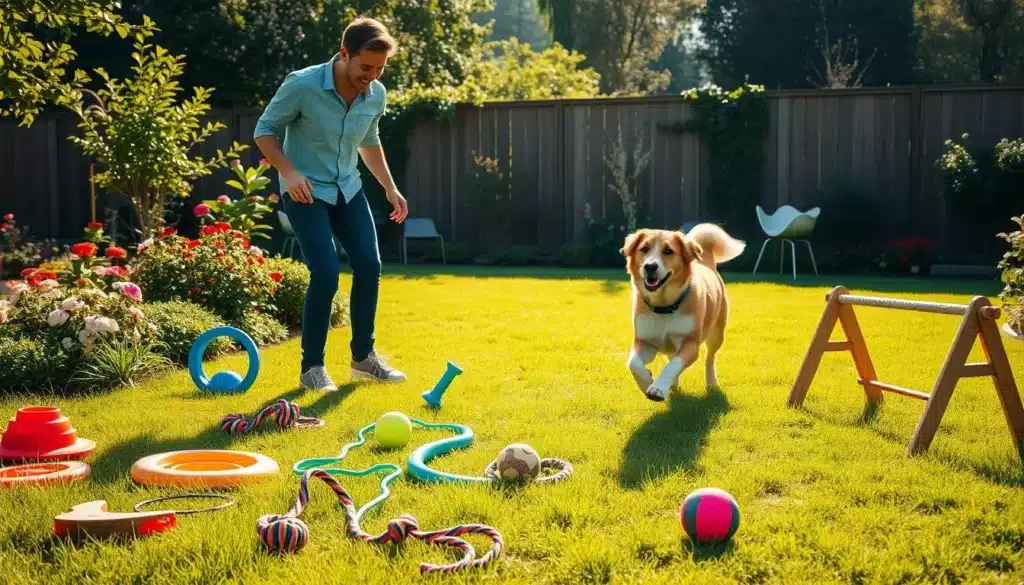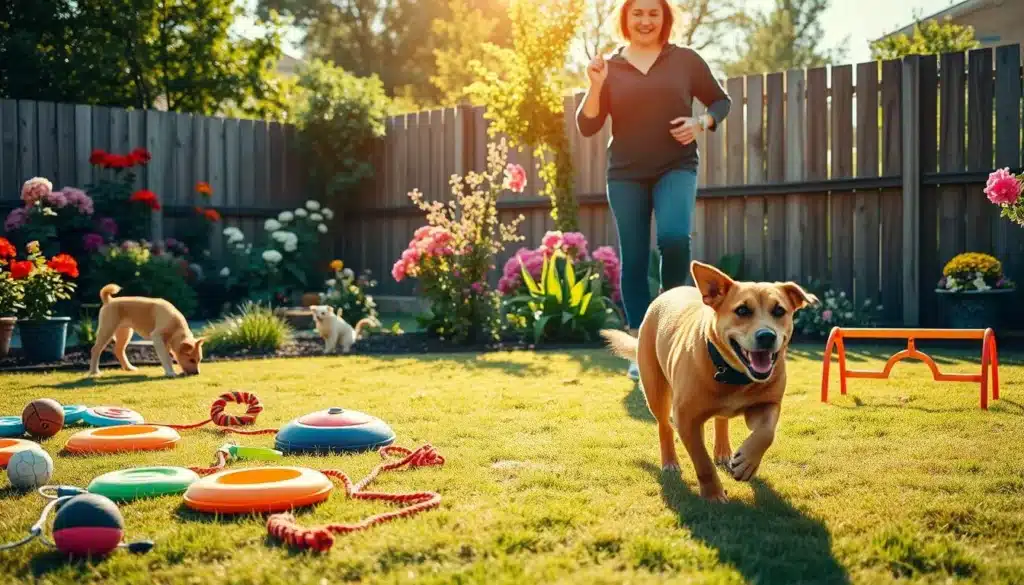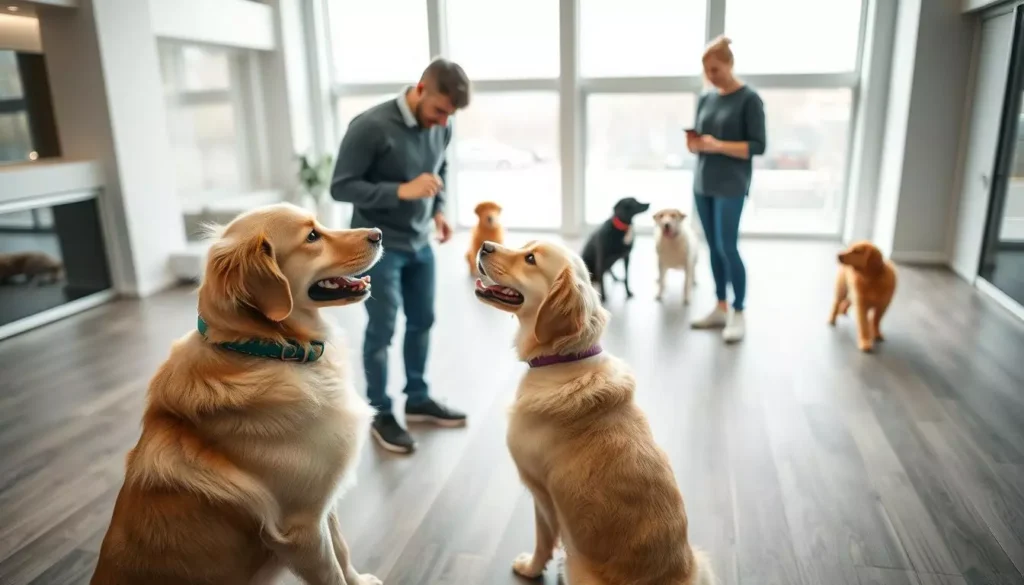When I first brought my dog home, I was overjoyed. But soon, I faced a big challenge: persistent barking. This sound fills my mornings and evenings, reminding me of my furry friend but also causing frustration.
I learned that knowing why dogs bark is key to a peaceful home. This article shares easy ways to stop dog barking. It covers the reasons and how to manage them, based on my experience.
Key Takeaways
- Understanding the root causes of dog barking is essential.
- Consider environmental changes to minimize distractions.
- Training your dog to recognize the "quiet" command can be effective.
- Proper exercise plays a crucial role in reducing barking.
- Engaging your dog with interactive toys can alleviate boredom.
- Address separation anxiety to tackle barking when left alone.
Understanding Dog Barking
Barking is a key way dogs talk to each other. Many owners love it when their dogs bark to warn them of strangers or dangers. But, too much barking can cause trouble in everyday life.
Dogs bark for many reasons, like to protect their territory, get attention, or feel anxious. Knowing why a dog barks helps me teach them better. This way, we can all live in peace.
Understanding how dogs communicate makes our bond stronger. Each bark means something different. Learning these messages helps us connect better with our dogs.
Causes of Excessive Dog Barking
Understanding why dogs bark can help us fix the problem. Each bark means something different. Knowing this helps us find the right way to stop it.
Territorial Barking
Dogs bark when they feel their space is being threatened. This is common when they see strangers or other animals. They want to protect their home.
Training and socializing can help. It teaches them not to bark so much, especially if they're protective.
Alarm Barking
Alarm barking is when dogs bark at noises or movements. Some dogs are very sensitive and bark at everything. This can be a lot.
Knowing what makes them bark helps. We can make their environment quieter or teach them to ignore it.
Attention-Seeking Barking
Some dogs bark to get attention. They might want to play, eat, or just be with someone. This kind of barking can be a problem.
Using positive training can help. It teaches them to behave without barking for attention.

| Type of Barking | Causes | Management Strategies |
|---|---|---|
| Territorial Barking | Response to intruders or unfamiliar animals | Training, socialization, and controlled introductions |
| Alarm Barking | Reaction to sounds or movements | Desensitization and environmental control |
| Attention-Seeking Barking | Desire for play, food, or companionship | Consistent training and positive reinforcement |
Identifying the Type of Barking
Understanding dog barking can really help you connect with your pet. Different barks mean different things. For example, a dog might bark excitedly when it sees a friend. On the other hand, a sharp bark could mean it's feeling scared or protective.
Knowing what your dog is trying to say can be a big help. It's all about paying attention to how often and loudly they bark. This tells you what they're trying to communicate.
Context is key when figuring out why your dog is barking. To make it easier, I've put together a table. It shows the different types of barking and what they might mean.
| Type of Barking | Characteristics | Possible Interpretation |
|---|---|---|
| Greeting Bark | Short, high-pitched, happy | Excitement to see someone |
| Alarm Bark | Sharp, loud, urgent | Warning of potential danger |
| Territorial Bark | Deep, intense, repetitive | Protective behavior over space |
| Attention-Seeking Bark | Persistent, whining tones | Desire for attention or play |
| Fearful Bark | Low, shaky, sporadic | Discomfort or anxiety about a situation |
With this knowledge, you can better understand your dog's barking. This can help you respond in the right way. It makes for a happier home for both you and your dog.
How to Manage Surroundings to Reduce Barking
Creating a good environment for my dog is key to reducing barking. Simple changes at home can help. This makes our lives more peaceful.
Blocking Views
Blocking dog views is a smart move. It stops visual triggers that cause barking. Using curtains or window films keeps my dog calm by hiding outside sights.
Providing Familiar Sounds
Adding familiar sounds also helps. Leaving the TV on or playing soft music when I'm away is comforting. It makes my dog feel less lonely and barks less.
| Strategy | Benefits |
|---|---|
| Blocking Views | Reduces territorial barking, minimizes distractions from outside |
| Providing Familiar Sounds | Offers comfort, reduces anxiety, lessens barking when left alone |
Training Your Dog to Bark Less
Teaching your dog to bark less needs understanding and consistency. The "Quiet" command is a powerful tool. It helps control barking and teaches my dog what sounds are okay.
Teaching the “Quiet” Command
To start teaching the quiet command, I create a calm environment. This helps my dog learn quickly. Here's how it works:
- Wait until my dog starts barking and then gently say "Quiet" in a firm but calm tone.
- As soon as my dog stops barking, even for a brief moment, I immediately praise and reward them with treats or affection. This positive reinforcement strengthens their understanding.
- Repeat this process consistently, gradually extending the time before offering the reward for remaining quiet.
- Over time, I begin to associate the quiet command with moments of silence, helping my dog learn when it's appropriate to bark and when it’s time to be quiet.
Using the quiet command effectively helps control barking and strengthens our bond. Consistent practice and positive reinforcement are essential for a quieter home.
Providing Adequate Exercise for Your Dog
Regular dog exercise has changed my dog's behavior for the better. A well-exercised dog is calmer and quieter. Daily walks, fetch, or agility training help burn off energy and boost health and happiness.
I make sure to mix up activities to keep my dog's mind and body active. This keeps them happy and reduces barking.
To get the most out of exercise, I plan two to three play sessions a day. This keeps boredom and anxiety at bay, which helps cut down on barking. Playdates with other dogs also improve their social skills and reduce barking.

Encouraging Positive Socialization
Promoting dog socialization is key to a well-adjusted pet. A well-socialized dog is less likely to bark too much, especially around strangers. I've seen great results by introducing my dog to many people and pets.
By rewarding calm behavior, I create a safe and confident space for my dog. This approach helps him feel more at ease.
Creating positive experiences for dogs is vital. Meeting friendly people and other pets helps reduce anxiety. I make sure these meetings are positive, helping my dog see new things as fun, not scary.
Having safe spaces during these introductions lets my dog explore at his own pace. This helps reduce barking urges over time.
Also, taking my dog to dog parks or pet-friendly events is beneficial. These experiences help reduce territorial barking. My dedication to socialization strengthens our bond and improves his overall happiness.
Using Interactive Toys to Decrease Boredom
Interactive toys for dogs are a great way to stop unwanted barking. They keep my dog busy and mentally stimulated. This helps a lot in reducing boredom barking.
Puzzle toys that give out treats are especially good. They challenge my dog and reward him with treats. This makes the experience fun and rewarding for him.
Using these toys, I see a big drop in my dog's attention-seeking barking. When he's busy solving puzzles or finding hidden treats, he doesn't bark as much. This change helps keep our home quiet and peaceful.

How to Stop a Dog from Barking When Left Alone
Dealing with a dog's barking when I leave the house can be tough. It often comes from separation anxiety. So, it's key to make my dog feel safe when I'm away.
Using crate training is a big help. It makes a cozy space for my dog. With fun activities inside, my dog is less likely to bark when I'm gone.
Crate Training Tips
Proper crate training makes my dog feel secure when I'm not there. Here are some tips:
- Choose a durable, well-ventilated crate that fits my dog's size.
- Let my dog get used to the crate at their own pace.
- Use positive reinforcement to encourage my dog to enjoy the crate.
- Don't use the crate as punishment to keep it positive.
Safe Toys for Play
Safe dog toys keep my pet busy and happy when I'm out. They help prevent boredom and barking. Here are some good options:
| Toy Type | Description | Benefits |
|---|---|---|
| Chew Toys | Durable toys made from rubber or nylon. | Promote dental health and satisfy chewing instincts. |
| Puzzle Toys | Toys that hide treats, challenging dogs to figure them out. | Stimulate mental engagement and keep dogs busy. |
| Stuffed Kongs | Hollow toys that can be filled with treats or peanut butter. | Encourage interactive play and can provide hours of entertainment. |
Overcoming Separation Anxiety in Dogs
Separation anxiety in dogs can show up in many ways, like barking a lot when I leave. Spotting signs like pacing or destructive acts helps me act fast. It's key to understand these signs to tackle the root problems.
Gradual desensitization is a great way to help my dog get used to being alone. I start with short times alone and slowly add more. This method lessens the stress of being left behind. I also use counter-conditioning, making my leaving a positive experience with treats or toys.
For really tough cases of separation anxiety, getting help from a dog behaviorist is a good idea. They offer specific advice and help me manage my dog's anxiety better. This improves my dog's emotional health.
Implementing Behavior Modification Techniques
Behavior modification for dogs is key in reducing excessive barking. Techniques like desensitization and positive reinforcement work well. Desensitization helps my dog get used to triggers that cause barking in a safe way.
Positive reinforcement is also crucial. I reward my dog with treats or praise when he's calm. This encourages him to be calm more often, aligning with my goal of reducing barking.
Being consistent is vital. Regular use of these techniques can greatly change my dog's behavior. A routine helps my dog know what's expected, making it easier to follow.
In conclusion, changing my dog's behavior takes patience and determination. Using desensitization and positive reinforcement in my training helps create a quieter home.
Seeking Help from Professionals
On my quest to tame my dog's barking, I found that professional dog training is a game-changer. Certified trainers and animal behaviorists know how to spot the root of the problem. They craft plans that fit my dog's specific needs, tackling the causes of the barking.
Experts bring a wealth of knowledge on behavior. They teach me how to use this knowledge with practical training methods. This combo gives me the tools to stop the barking for good. They also teach me how to keep up the training at home, making sure we're on the same page.
Dealing with persistent barking or anxiety-related yapping? Trained professionals are your best bet. By investing in their expertise, you can create a quieter, happier home for both you and your furry friend.
Conclusion
Dealing with dog barking needs a mix of strategies for each dog. This article looked at ways to understand why dogs bark, train them, and change their environment. These methods help reduce barking and make my dog happier.
Good dog training changes my dog's behavior for the better. It helps us communicate better and live in peace. Training patiently and giving my dog social time are key steps to stop unwanted barking.
Changing my dog's behavior takes time and effort. By sticking to a routine with these techniques, we can live together peacefully. These steps not only solve the barking problem but also make our bond stronger, creating a happy home for both of us.




